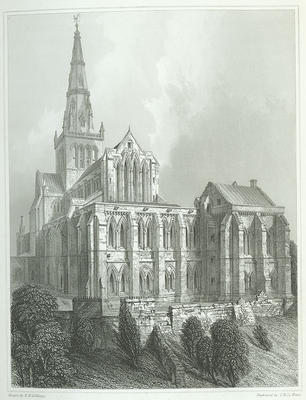
A view of Glasgow Cathedral from the east, drawn by Robert Billings in 1848. The chapter house is on the right. In the foreground, the ground falls away in a steep slope down to the Molendinar Burn. This has the effect of elevating the choir, and makes the building's appearance still more imposing when viewed from the east.
The cathedral originally had a wooden spire, which burned down after being struck by lightning in 1400. A stone replacement was begun a few years later by Bishop William Lauder, and completed by his successor John Cameron. Lauder's coat of arms is inscribed on the parapet of the central tower.
The spire was damaged by lightning again in the 18th century, after which repairs were carried out by Mungo Naismith. It rises to 220 feet above the floor level of the crossing, a rather modest height in comparison with many cathedrals. There are windows on four levels.
Reference: Mitchell Library, f720.941BIL
Reproduced with the permission of Glasgow City Council, Libraries Information and Learning
Keywords:
chapter houses, choirs, Glasgow Cathedral, Molendinar Burn, spires, towers, windows
You have 0 images in your photo album.